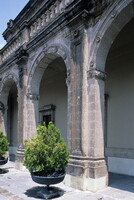Museo Nacional de Historia
Hofmann, Julius

Download1A2-M-MC-MH-A8_cp.jpg (600.3Kb)
Alternative Titles
Maximilian's Castle
Castillo de Chapultepec
Date
1786-1878Description
The physical expansion of the city also began in the 1860s. The Habsburg emperor Maximilian ordered the construction of the Avenida del Imperio (now Paseo de la Reforma), a wide boulevard that joined the city centre with the imperial residence at the Castillo de Chapultepec (now housing the Museo Nacional de Historia). The 18th century base of the residence was designed by the Catalonian Agustín Mascaró (1786) with a refashioning in 1864-1865 by Ramon Rodríguez Arango ity with the assistance Eleuterio Méndez. The tower was amplified in 1878 by Angel Anguiano who was both an architect and an astronomer. Maximilian brought in other European and Mexican architects including Hofmann. Castillo de Chapultepec was used as the official presidential residence until 1944, when it became the National History Museum.; The physical expansion of the city also began in the 1860s. The Habsburg emperor Maximilian ordered the construction of the Avenida del Imperio (now Paseo de la Reforma), a wide boulevard that joined the city centre with the imperial residence at the Castillo de Chapultepec (now housing the Museo Nacional de Historia). The 18th century base of the residence was designed by the Catalonian Agustín Mascaró (1786) with a refashioning in 1864-1865 by Ramon Rodríguez Arango ity with the assistance Eleuterio Méndez. The tower was amplified in 1878 by Angel Anguiano who was both an architect and an astronomer. Maximilian brought in other European and Mexican architects including Hofmann. Castillo de Chapultepec was used as the official presidential residence until 1944, when it became the National History Museum. Source: Wikipedia; http://en.wikipedia.org/wiki/Main_Page (accessed 6/17/2009)
Type of Work
palace; museumSubject
architectural exteriors, rulers and leaders, Mexico History, Hapsburg, Habsburg, Second Mexican Empire, Nineteenth century
Rights
Rights Statement
Licensed for educational and research use by the MIT community only